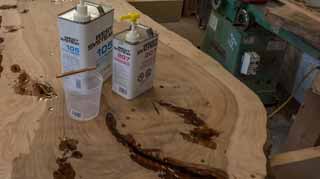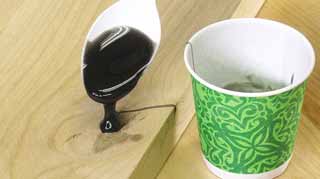You must have seen those epoxy resin video tutorials online. They look amazing, right?
Well, you can use epoxy for your projects too. Working with epoxy is no rocket science. If you are into woodworking, you can easily handle epoxy too.
The advantage of epoxy is that it can be used for a wide number of applications. From creating creative projects to just filling wood cracks, it can be used for so many things.
When it comes to filling wood cracks, most of us prefer putty or wood filler for large holes. But you can do the same thing with epoxy as well. Epoxy will prove to be superior to the other substances.
Just so you know epoxy is an adhesive. It cannot only fill the cracks in your project, but it can also bond to the insides of those gaps. This will help hold the pieces together. It can create a stronger bond than most other paste fillers.
In comparison to other fillers, epoxy flows better. It makes it easier for you to fill up the wood cracks quickly. Also, it goes deeper to form a stronger bond within the crack.
Another great thing about epoxy is that you can color it using different pigments. This means you can even match the color of the wood or create any other fancy patterns.
Epoxy gives you the right to be creative. In this post, we will tell you how to fill cracks in wood with epoxy. If that’s what you have been looking for, then you should give this article a read.
Accessories That We Need For This Project
To get started, you need to first arrange for all the accessories or tools that are required for the project. If you are doing this for the first time, then you may have little or less knowledge about the things you need. To help you out, we have made a list of all the accessories that you need for the task.
- Two-part liquid epoxy
- Disposable mixing cup
- Pigment
- Disposable spoons or stir sticks
- Blue masking tape
- Denatured alcohol
- Black felt tip marker
- Needle
- Latex gloves
These are all easy to get items that you can get from your nearby hardware store. So it shouldn’t be a problem for you to complete the project at home.
In case, you don’t get some of the items, you can order it online. Also, the items are quite affordable.
How to Fill Cracks in Wood with Epoxy?
Now coming to the main topic of filling wood cracks with epoxy. In this section, we will explain to you the steps in detail, so that you don’t find the process difficult. If you are doing this for the first time, you will find this guide to be helpful.
We will start right from the basics, so it’s easier for you to understand.
1. Select Right epoxy

To get started with filling wood cracks, you need a epoxy that works good with wood. The strength of the fill is dependent on the strength and quality of the epoxy you use.
If you want the best results and want the wood to last long, you wouldn’t want to waste your time with cheap products. Most bottom shelf products are either not good enough or are made of using older formulations.
But at the same time, you also don’t need a very high-end product that is used for creating clear casting and surface layers. This means you have to use aim for something in the middle.
You should go for a known brand that manufactures the quality product. You need to be sure that the product will not fail your project.
2. Choose the right open time
Another important thing you need to consider is the amount of open time your epoxy will allow you. By the open time, we mean the amount of time that you will get to work with the substance while it remains in the liquid state.
Once it passes through the amount of open time it will turn into a gel-like substance and will no longer remain flowy. This will make it harder for you to work with it.
For most epoxy products, they offer an open time from 5 to 60 minutes. If you don’t have big cracks to fill, then you can go for epoxy products with five minutes of open time.
However, if you have larger cracks to fill or want to create something fancy that will require more time, you should go for a product that will give you more open time. In this case, an open time of 60 minutes will be the best option.
The longer open time you get, the better it is for you. This will give you more time to flow the product where you want it to. Not just that but you can also color the product. So before, you get your epoxy, you should check the amount of open time it gives.
3. Tint the epoxy
The next step is to tint the epoxy. This is not a mandatory step as you can use the epoxy resin without colors as well. But most woodworkers prefer to color the epoxy to either match the color of wood or to create attractive patterns.
Adding tint to epoxy is perhaps the best thing. You can add any color you want. You can even add multiple colors to create colorful patterns.
The good thing is that you can get a wide variety of pigments to choose from. This means you can get the tint of your choice easily.
Color pigment is available in powder form which needs to be mixed with epoxy when it is in a liquid state. You should stir it well using a disposable spoon or stir stick. This will help develop the color you want.
If you want your wood cracks to disappear, then you are advised to match the color of your epoxy with the surrounding wood. This trick is also applicable when you are doing inlay work.
You can add pigment to the epoxy to match the background color. Tinting helps you to hide differences or gaps between your inlay pieces and also the surrounding wood. By matching the color of epoxy with the surrounding wood, you can make it look natural.
4. Filling Cracks in the Wood

Here comes the main part of the task and that is filling the wood cracks. Now that you are ready with your tinted epoxy, you should start filling the wood cracks before the substance turns into a gel. This step is probably the easiest. All you have to do is pour the epoxy from the container into the crack.
Here is some tip that can make the process faster and easier for you.
- At first, you should check the bottom of the wood with the crack. If the crack goes all the way through, you need to put use a dam to prevent the epoxy from running out from the other side.
- In this case, you can use masking tape to cover or block the bottom of the crack. Press it against the wood on both sides to create a secure seal. This will help hold your epoxy and prevent it from running out from the other side.
- No matter how deep the crack is, you need to fill it. In case, you fill it up till the top, no worries, as you can level it using sandpaper later.
- Give it a full 24 hours to cure. This is an important part, therefore, you shouldn’t skip it at any cost. If you don’t let it get cured, the epoxy will not standstill.
5. Sand the fills level
Once your fill is cured and ready, you can use a sandpaper to level the rest of the wood and fill. The best option would be to use a sanding block along with a sanding paper.
The advantage of using a sanding block is that it will automatically target the higher spots. This is exactly how you need to level the epoxy with the rest of the wooden surface.
You can wrap your sanding block with a sanding paper and get started with the task. This may take a while till you level the entire thing, so you need to be a little patient.
You should also check your sandpaper often, to prevent the epoxy from getting wadded up in between the grains on the sandpaper. If this happens, then your sandpaper will become less effective and therefore, you won’t get the desired effect.
You need to continue sanding until the crack becomes level with the rest of the surrounding surface. After that, you should sand a wider area so that you can blend everything. If you can do it right, then you will have an almost invisible crack.
6. Finishing The surface

This is the last step where you need to polish the fill and wood. Once you are done with all your work, you will need a clear spot where you can finish the rest of your project.
If you are using oil, then you should know that it is not going to be absorbed the same way in epoxy as wood. In this case, you should choose a film. You need to give it a smooth and shiny finish like a lacquer.
Tips and Cautions When Filling Wood Cracks
Here are some tips and cautions that you should follow while getting your project done:
1. You should wear a mask and latex gloves while working with epoxy. This is needed for both safety and convenience. Air bubbles will occur when you mix two resin components. Although you cannot prevent them you can remove them without a problem. After the casting process, you can take a hot air gun and move it over the surface in quick motions. This will make the bubbles will rise and disappear.
Conclusion
The process of filling wood cracks with epoxy should be clear to you. Epoxy is a kind of adhesive that can be used for a variety of applications including filling wood cracks. It is easy to do the process if you get the steps right.
There are many advantages of using epoxy in place of other wood fillers. It not only flows better, but you can also colour the substance according to your wish. It’s really easy to use epoxy when you know the steps correctly. With the help of this guide, you should be able to complete your project in no time.
- How to Choose Wood Filament: A Complete Guide - July 17, 2021
- 10 Best Propane Forge Reviews - June 30, 2021
- Best Circular Saw Blade for Plywood : Top 10 Picks - June 30, 2021


